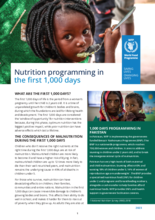Ending malnutrition
- 45 million
- children under 5 suffer from wasting (low weight for height)
- 148 million
- children under 5 suffer from stunting (low height for age)
- 2.8 billion
- people can’t afford a healthy diet
WFP's goal of a world with zero hunger can only be achieved by addressing the immediate and underlying causes of malnutrition. The right nutrition at the right time is fundamental to stop people dying in humanitarian emergencies, to ensure optimal health and development throughout life, and for the long-term prosperity of countries.
What is malnutrition?
Malnutrition is a general term that covers both undernutrition and overweight/obesity. Symptoms of malnutrition occur when a person’s nutrient or energy intake does not meet, or exceeds, their body’s requirements. Malnutrition costs the global economy US$3.5 trillion a year. It is also the single largest contributor to disease. Undernutrition alone is the underlying cause in almost half of all deaths in children under 5.
What are the different types of malnutrition?
Acute malnutrition (or wasting)
Chronic malnutrition (or stunting)
Micronutrient deficiency
Overweight and obesity
What are the causes of malnutrition?
Every country in the world is affected by malnutrition in one form or another. Low-income countries face an unacceptably high burden of undernutrition, and almost all countries have growing numbers of people affected by overweight or obesity. The lack of affordable, nutritious diets is at the centre of this crisis.
Ineffective food systems, recurrent humanitarian crises, poverty and gender inequality are barriers to people accessing nutritious food. The severity of malnutrition and inadequate diets is most profound in countries that face persistent crises, including those resulting from conflict, climate change, disasters and economic shocks.
What are the long-term effects of malnutrition?
Malnutrition perpetuates the cycle of poverty. It stops the development of nations and prevents a more equal world through hindering people’s development and potential. Malnutrition affects brain development, educational achievement and people’s long-term health – imposing huge costs on both individuals and national economies. Undernutrition costs up to 16.5 percent of GDP across Africa. In Latin America and the Caribbean, the double burden of malnutrition costs up to 16.3 percent of GDP. Meanwhile, in Asia, undernutrition costs up to 11 percent of GDP. In low- and middle-income countries, childhood stunting is estimated to cost the private sector US$135 billion every year in lost sales.

How is WFP working to end malnutrition?
WFP’s primary focus is to reach people who are at greatest risk of malnutrition and inadequate diets. Much of our work targets young children and pregnant and breastfeeding mothers, as they are the most vulnerable to undernutrition. Supporting good nutrition during the 1,000-day window from pregnancy to age 2 is also the most cost-effective way to avert malnutrition, and to ensure good growth and development throughout life. We also support other groups who are left furthest behind and who are most vulnerable to malnutrition, for example those living with HIV.
We adopt a ‘prevention first’ approach, working to safeguard the nutrition of those in humanitarian crises, and to support access to healthy, nutritious diets in more stable settings. Where WFP’s food assistance is needed, we work to ensure it is nutritionally adequate. We also provide specialized nutritious foods to prevent malnutrition and to aid the recovery of those who are already malnourished. We support the improvement and sustainability of food systems, promoting the local production of nutritious foods, and facilitating the fortification of staple foods with vitamins and minerals.
We work with governments and other nutrition partners to monitor vulnerabilities. This includes using innovative approaches in some of the most inaccessible regions on the planet.
In focus
In Haiti and Gaza, mothers and children in the crosshairs of malnutrition emergencies
Story | 6 August 2024
In Mali's restive Segou region, WFP and UN partners give women tools to build resilience
Story | 3 January 2024
Zambia cooks up solutions to hunger and climate change
Story | 4 December 2023
Cost of cuts: Funding shortfalls threaten to push millions facing hunger to brink of starvation
Story | 12 September 2023
‘Breastfeeding is a lifeline’: Women in DRC, South Sudan and Syria talk nutrition
Story | 1 August 2023
DRC cooks up solutions for child malnutrition
Story | 6 July 2023





